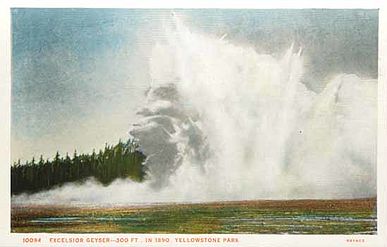Excelsior Geyser
| Excelsior Geyser Crater | |
|---|---|
 Eruption, 1888 by F. Jay Haynes | |
 | |
| Name origin | Hayden Survey, 1871 |
| Location | Midway Geyser Basin, Yellowstone National Park, Teton County, Wyoming |
| Coordinates | 44°31′35″N 110°50′13″W / 44.526321°N 110.8368778°W[1] |
| Elevation | 7,257 feet (2,212 m)[2] |
| Type | Fountain-type Geyser |
| Eruption height | Boil – 300 feet, and just as wide. |
| Frequency | When it was active, every 2 minutes to 5 hours |
| Duration | When it was active, 1–3.5 minutes |
| Discharge | 4,000–4,050 gallons per minute – when not erupting |
| Temperature | 199 °F (93 °C)[3] |
Excelsior Geyser Crater, formerly known as Excelsior Geyser, is a dormant fountain-type geyser in the Midway Geyser Basin of Yellowstone National Park in the United States. Excelsior was named by the Hayden Geological Survey of 1871.[4]
Description
The Excelsior Geyser pool discharges 4,000 to 4,500 gallons (15,100–17,000 L)[5] of 199 °F (93 °C)[3] water per minute directly into the Firehole River. In the late 19th century (and possibly 1901), it was an active geyser that erupted frequently. Most eruptions were about 100 feet high, although some exceeded 300 feet (91 m) in both height and width. It now boils as a productive hot spring most of the time.
Activity
Excelsior goes through periods of activity and inactivity. It was initially reported in 1869 as a large crater with a pool that had evidence of eruptions but none were seen until 1881 at which point, the geyser became active again. In 1888, photographer F. Jay Haynes took the only known photograph of the geyser in full eruption, capturing the power and violence of these eruptions. The eruptions of this period were described by Yellowstone superintendent Philetus Norris[6] as:
"...simply incredible, elevating to heights of 100 to 300 feet, sufficient water to render the Fire Hole River, nearly 100 yards wide, [into] a foaming torrent of steaming hot water, and hurling rocks of from one to 100 pounds in weight, like those from an exploded mine, over surrounding acres."
By 1888, it had been reported as "extinct". An expedition by the U.S. Fish Commission in the summer of 1890 found that it had become an active geyser that erupted frequently[7] but this active period soon ended. It is believed that the powerful eruptions had broken off sections of stone that had damaged its internal plumbing system.[6]
In 1985, Excelsior returned to activity for a 46-hour period from September 14 to 16. These eruptions were relatively small at 30 feet (9.1 m) but a few were as much as 80 feet (24 m) tall and 100 feet (30 m) wide. All of these eruptions lasted about 2 minutes at intervals of 5 to 66 minutes.[5]
Between 2004 and 2006, Excelsior did have violent boiling strong enough to be considered as eruptions. This boiling reached between 5 and 10 feet (1.5 and 3.0 m) and had a duration of seconds.
|
References
- ^ "Excelsior Geyser Crater". Yellowstone Geothermal Features Database. Montana State University.
- ^ "Excelsior Geyser Crater". Geographic Names Information System. United States Geological Survey, United States Department of the Interior.
- ^ a b "Thermal Springs List for the United States". National Geophysical Data Center, NOAA.
- ^ Bauer, Clyde Max (1937). The Story of Yellowstone Geysers. Saint Paul, MN: Jack Ellis Haynes.
- ^ a b "Excelsior Geyser". Geyser Observation and Study Association (GOSA). 2006. Archived from the original on 2014-04-07. Retrieved 2010-10-29.
- ^ a b Whittlesey, Lee (Spring 1990). "Monarch of All These Mighty Wonders: Tourists and Yellowstone's Excelsior Geyser, 1881-1890". Montana: The Magazine of Western History. 40 (2): 2–15.
- ^ Linton, Edwin (Dec 28, 1928). "The Excelsior Geyser, Yellowstone National Park". Science. 68 (1774): 644–645. doi:10.1126/science.68.1774.644.b. S2CID 239861744.








